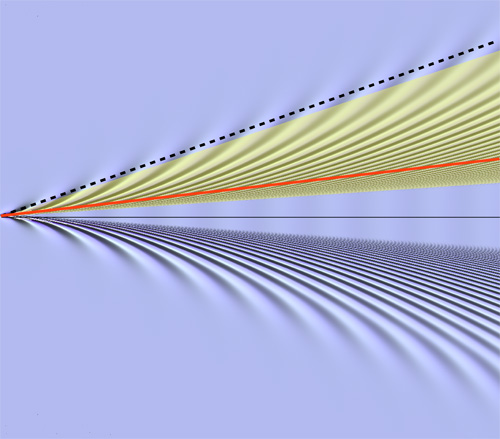
Wake angles: the black dashed line shows the outer edge of the wake and is at the angle predicted by Lord Kelvin. The red line shows the maximum amplitude of the wake and is at the angle predicted by Marc Rabaud and Frédéric Moisy. (Courtesy: A Darmon, M Benzaquen, E Raphaël)
By Hamish Johnston
Loyal readers may recall that earlier this year we published a news article entitled “Physicists rethink celebrated Kelvin wake pattern for ships” that reported on work done by two French physicists. While looking at Google Earth images of ships moving through the sea, Marc Rabaud and Frédéric Moisy noticed that some of the wakes did not conform to a prediction made years ago by Lord Kelvin, the renowned Victorian physicist, engineer and entrepreneur.
Kelvin showed that the angle that each arm of the V-shaped wake makes with the centre line is 19.47°, irrespective of how fast the boat is travelling. It is a universal pattern that even holds true for a duck traversing a pond. Physicists had spotted narrower wakes before, but that was usually explained away in terms of special situations such as a ship moving through shallow water, for example.
Rabaud and Moisy weren’t happy with such explanations and in May they unveiled numerical simulations that suggested that there is a transition velocity above which Kelvin’s description no longer applies. In this new regime, the wake is expected to narrow as the velocity increases – something that they say is backed up by satellite images.
Not everyone was convinced, and now an independent trio of physicists in France – Alexandre Darmon, Michael Benzaquen and Elie Raphaël of ESPCI ParisTech – has done further calculations that seem to suggest that the declarations of Kelvin and Rabaud/Moisy are both correct.
Raphaël and colleagues have shown that for fast-moving ships, the angle that defines the outermost limit of the wake is that calculated by Kelvin. However, the angle that defines the maximum amplitude of the wake decreases as the velocity of the ship increases, as predicted by Rabaud and Moisy.
The latest paper is called “A solution to the Kelvin wake angle controversy“.
So no wake is needed for Kelvin’s theory – and to think we could have doubted one of the greatest minds of the Victorian era!
Guidelines
Show/hide formatting guidelines
this text was deletedwhere people live in harmony with nature and animals</q>
Some text